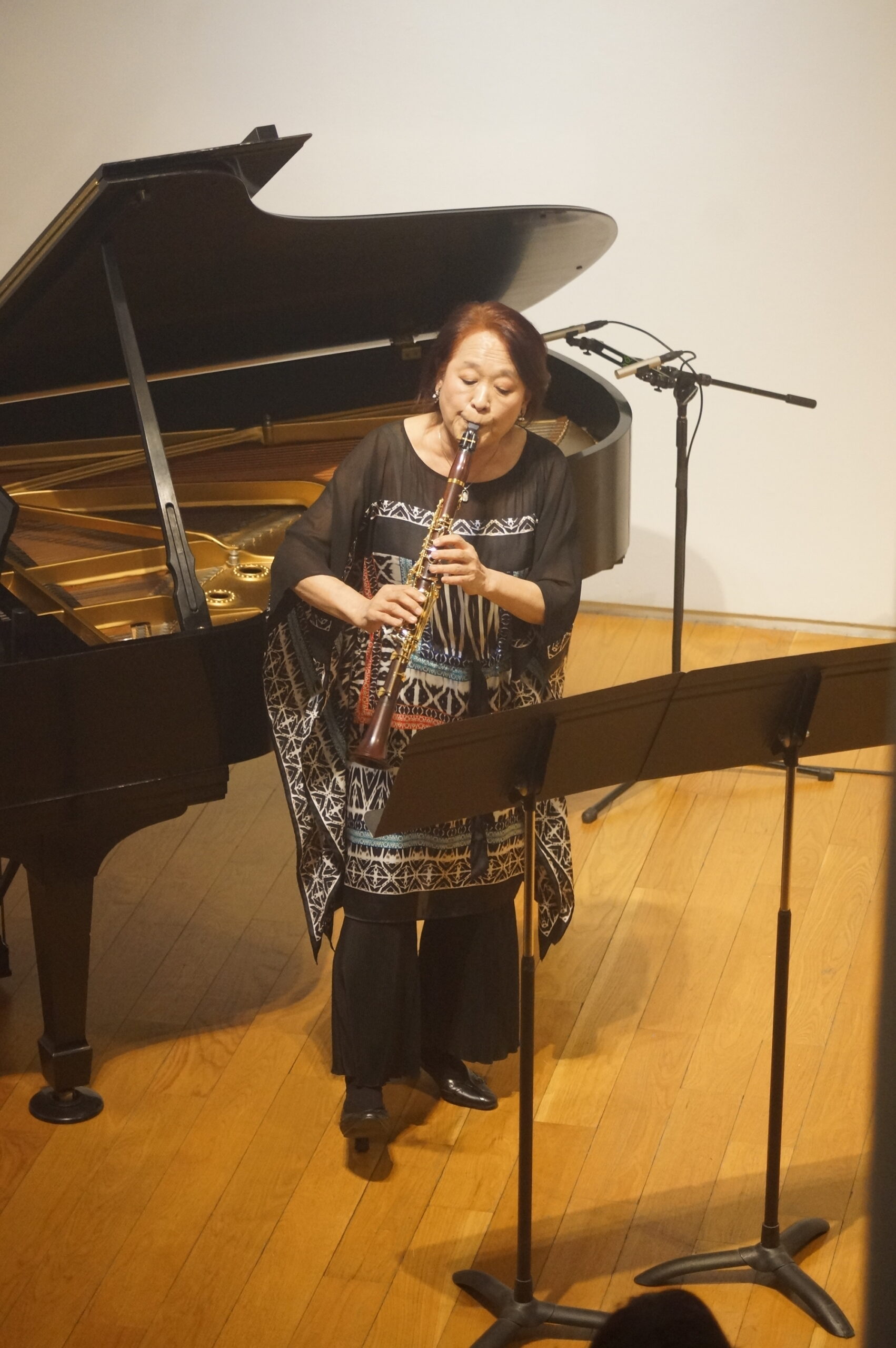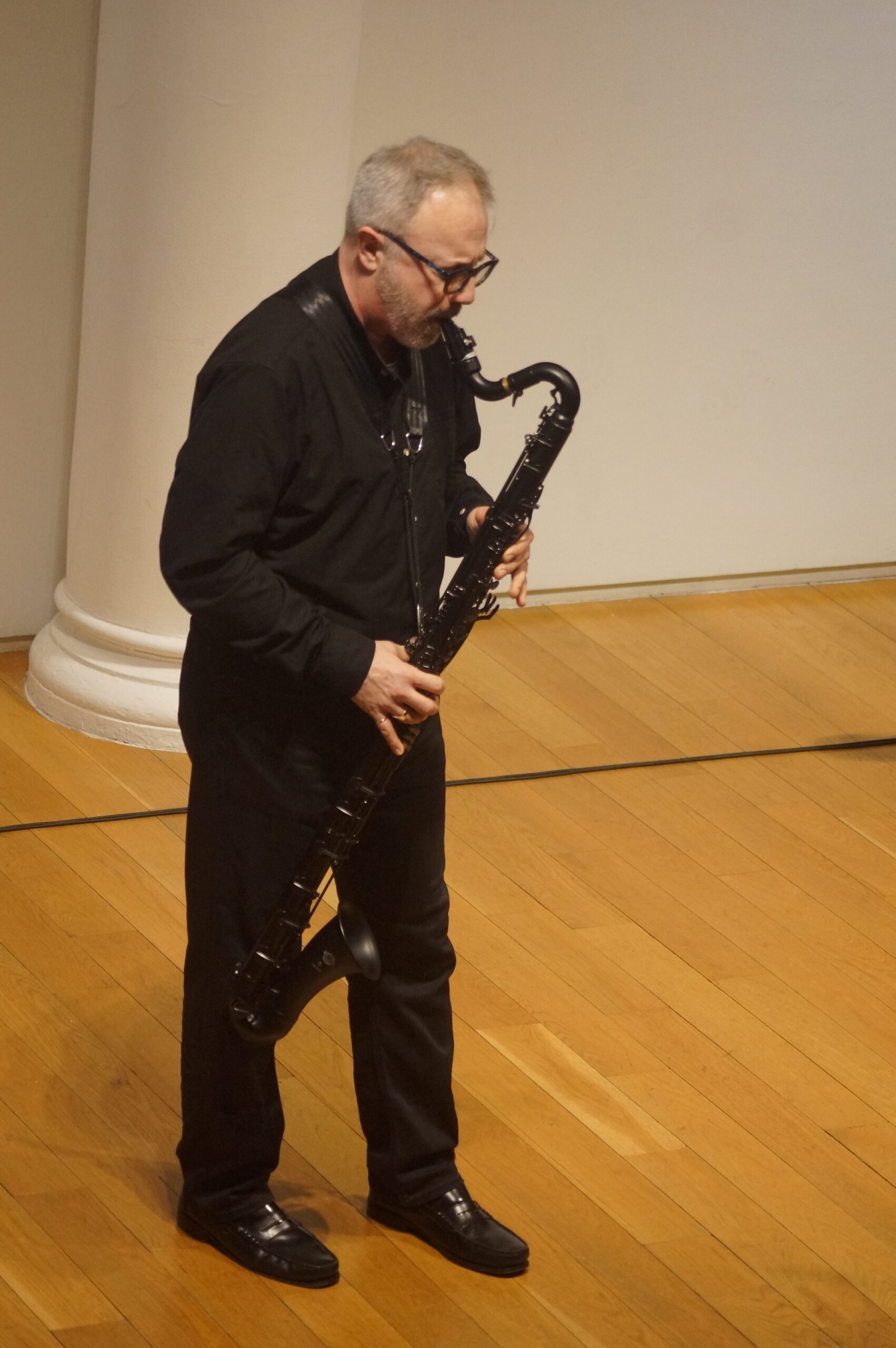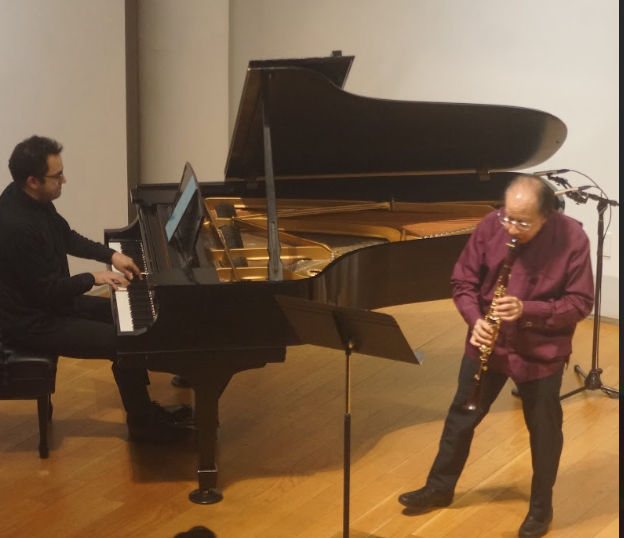WA Concert Series Presents “The World of the Expanded Clarinet” in Review
Charles Neidich, clarinet; Ayako Oshima, clarinet
Michael Lowenstern, bass clarinet; Mohamed Shams, piano
Tenri Cultural Institute, New York, NY
March 1, 2024
The Tenri Cultural Institute was packed this Friday as the WA Concert Series presented a “re-debut” program entitled “The World of the Expanded Clarinet” led by WA co-founders Charles Neidich and Ayako Oshima. It reminded us of how much we’ve been missing since March of 2020, when the onslaught of COVID-19 forced their hiatus (apart from some virtual offerings). I am happy to report that they are back and better than ever!
WA concerts have always been known for their fascinating, sometimes eclectic, programs, performed by dazzling musicians, with clarinetists Charles Neidich and Ayako Oshima (Mr. Neidich’s wife and partner) at the helm. Your reviewer (along with most of the music world) has admired the virtuoso playing of Charles Neidich for over four decades now (his biography being too crammed with honors and distinctions to relay but found here: Charles Neidich), and the brilliant Ayako Oshima has established herself as a formidable force in her own right – but Friday’s “dream team” was made still stronger with the inclusion of rock-solid pianist Mohamed Shams and ingenious bass clarinetist Michael Lowenstern.
The program incorporated old and new, including well-known nineteenth-century music by César Franck and Ernest Chausson and twentieth-century works of Nadia Boulanger (1887-1979), Yayoi Kitazume (b. 1945), and Edison Denisov (1929-1996), plus compositions by Mr. Lowenstern (b. 1968) and Mr. Neidich (b. 1953).
The evening started with Trois Pièces by Nadia Boulanger, a set originally composed for organ in 1911, arranged by the composer in 1914 for cello and piano, and transcribed for clarinet “last week” by Mr. Neidich, as he announced much to the amusement of the audience. The opening Moderato was a perfect welcome to the concert, with its dreamy clarinet lines floating over quasi-impressionistic piano accompaniment. The second piece, Sans vitesse et à l’aise,brought to mind the restrained sorrow of some of Ravel’s more solemn works and was delivered with eloquence. In both of these pieces, the clarinet handled the original cello lines with equivalent or heightened lyricism, sacrificing nothing, while in the third and final piece, Vite et nerveusement rythmé, the clarinet seemed actually to add a spiky precision to the work’s frenetic energy. Bravo to this wonderful addition to the clarinet transcription literature!
Ayako Oshima took the stage next to perform the U.S. premiere of a 2017 work by Yayoi Kitazume with its title translated from the Japanese as “Teetering Balance” and based on the Paul Klee painting of a similar title, usually referred to as “Unstable Equilibrium” (1922, watercolor over pencil). Until Ms. Oshima pointed it out, this listener was unaware that there were program notes (accessible by a QR code in the printed program), including a reprint of the Paul Klee artwork, so not having been able to envision the artwork before hearing it made listening an even more interesting experiment. There was only the music as a guide in what seemed a fascinating exploration of musical space. Upon later reading in Ms. Kitazume’s notes that she “wanted to construct a three-dimensional piece of music that blended time frames and directions of consciousness” the work and performance seemed in retrospect even more remarkably on target. Ms. Oshima painted with her clarinet a picture so vivid that most visual artists would be envious. It was a highlight of the concert.

Another highlight of the program was the performance by Mr. Neidich of the Sonata for solo clarinet (1972) by the important Russian avant-garde composer Edison Denisov, whose brilliance transcended Soviet beleaguering and blacklisting. We know from Mr. Neidich’s introduction that he personally knew Denisov from his own time in Moscow and that Denisov considered Mr. Neidich’s 1975 performance of the piece to be its premiere (in terms of authority if not chronology), and one could see why. The work is, among other things, a tour de force for the instrument, exploiting microtones, the haunting bending of pitches, flutter tongue techniques, fiendish leaps of register, and constant metric changes – and Mr. Neidich is clearly still a master of it all nearly fifty years later. Part of his power is that he projects the character and direction of each phrase as if playing it for the first time – never any “phoning in” – and even a lay person, who might be unaccustomed to navigating such challenging music, could grasp it. Particularly striking was the second and final movement, Allegro giusto, in which a quietly obsessive B-flat (concert pitch A-flat) asserts its presence persistently amid surrounding histrionics (suggesting the disproportionate havoc caused by something tiny, say, a mouse). To hear these disjunct roles achieved by a single player is amazing, and the way Mr. Neidich concluded the work with that final idée fixe note after a long rest made it hard not to gasp in reaction (whether or not an audience member could distinguish any pitch from a hole in the ground). That is communication through music, and that is what one has come to expect from WA concerts.
It is always interesting to hear a performer play his own music, and this evening’s inclusion of Why? (2020) by Charles Neidich (the in-person world premiere) was no exception. It offered the opportunity to hear the Neidich-Oshima clarinet duo in what was Mr. Neidich’s musical response to the “tragedy, misfortune, and injustice” (according to his notes) that loomed in the early stages of the pandemic but with “even more urgency in 2024.” The question “Why?” refers to “why people do not take the necessary step of joining together to protect humanity and the world we live in.” The duo made their statement with music of individual searching, incidental dissonance, and clashing parallel pursuits that never quite meet or settle.
The first half concluded with the balm of a more familiar style via the Andante et Allegro (1881) of Ernest Chausson. It was given a winning performance by Mr. Neidich with Mohamed Shams, whose collaborative skills rendered his considerable pianism almost parenthetical.
Every concert has its takeaway “discovery” – and, in this instance, that discovery greeted us after intermission. Billed on the program only as “Surprise” to be played by Michael Lowenstern, it turned out to be Mr. Lowenstern’s performance of his own bass clarinet version of Summertime from Gershwin’s opera, Porgy and Bess, based on an improvisation Mr. Lowenstern first recorded in 1994. It seems hard to believe that back when this reviewer was a doctoral student frequenting “record stores” (remember those?), she had never come across Mr. Lowenstern’s awe-inspiring performance; in retrospect, however, she just might have heard it in passing but assumed it was some kind of unusual jazz ensemble. You see, what Mr. Lowenstern does here is to become a one-man band. If one closes one’s eyes, one hears not just the clarinet singing out the famous melody, but the gradual entry of a percussion section through the equivalent of clarinet beat-boxing, miraculously the faint pizzicato of a double bass interwoven here and there, and myriad other wind evocations – all held together with a beat sometimes heard but sometimes simply felt. To hear it is a delight – but to see it is mind-boggling. It was a miraculous performance.

Mr. Neidich reemerged from backstage with evident pride in a musician he smilingly called “my progeny” and was then joined by Mr. Shams for the Sonata for violin and piano in A Major (1886) of César Franck, transcribed for clarinet by Mr. Neidich, himself. It was an unforgettable feat, especially after so much other music-making. Mr. Neidich’s playing, with tremendous support from Mr. Shams, made a great case for the clarinet’s ability to do just about anything. That being said (and with apologies), this listener is a diehard fan of the piece in its violin (and even cello) versions, still preferring the string timbres and still preferring the way the phrases seem somehow born to be bowed. It need not be an either-or proposition, though, as pianists know very well (as they plunder the entire orchestral repertoire) – so it is chiefly a personal preference. Such objects of “transcription desire” are like Mt. Everest – we have to climb it because it is there. This Franck transcription undoubtedly expands the repertoire for the clarinetists out there who can handle it, as has been done for the flute and any number of other instruments. After all, Franck “asked for it” by composing such a gorgeous piece of music. The resulting standing ovation was well deserved, and an encore of Autumn Song (October) followed, from Tchaikovsky’s The Seasons, in a touching clarinet-piano arrangement.
Unbelievably, the musical feast was followed by a gourmet feast – the creation of Ayako Oshima. Long may the WA concerts brighten the cultural scene in New York City!

